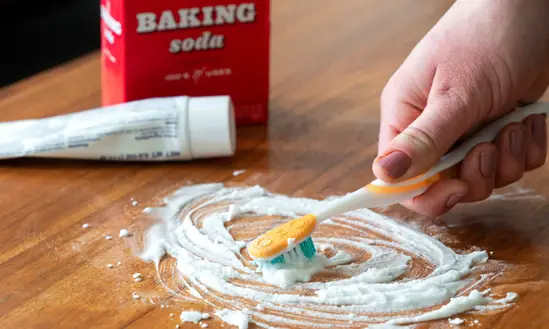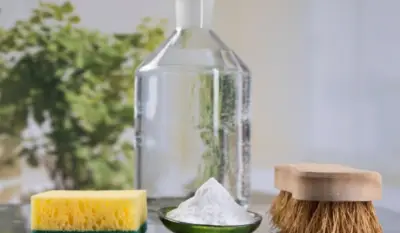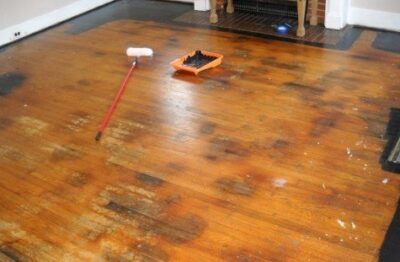Black wood floors are caused by mold infestation and excessive moisture. Once you spot a different kind of dark spot on your wood floor, the best thing to do is get rid of it as soon as you can.
You might be surprised as to why your wood floor has a black stain on it or as to why your entire floor is suddenly turning black.
If your main question is, “why is my wood floor turning black?” then stay tuned. This article covers everything you need to know about dark stains on oak wood floors and how to get rid of them quickly.
Differences Between Surface Staining and Wood Discoloration
Yes, many people confuse wood discoloration with black stains on the surface of the hardwood floor. These two words have completely different meanings. Although the majority of these wood stains come from exposure to excessive moisture but guess what, they are pretty easy to fix.

Wood coloration is mainly caused by exposing wood floors to excessive moisture, which allows molds to grow and interact with the floor wood, resulting in large dark stains on your wooden floor. A wood surface stain can come from water spillage such as coffee, pet urine, wine, etc., that turns into stubborn, ugly stains over time.
In summary, exposing your wood floor to moisture and allowing mold to settle on them are the main reasons why your wood floor has dark stains on them.
How to Prevent Black Stains on Wood Floors?
Of course, making sure these stains don’t get on your wooden floor in the first place is far better than looking for ways to get rid of them. Here are some tips on how to keep your hardwood floor safe from dark marks.

- Try to keep your wood floor dry and clean
- Wipe off any spilled water as soon as you can
- Protect your wood floor with a clear finish, such as polyurethane
- Close your windows when it rains
- Place your pets on a floor mat as pet urine stains can cause severe damage to hardwood floors
How to Kill Mold on Hardwood Floors?
Mold loves wet hardwood floors, and the best way to get rid of them is to keep your wood floor dry. You can use fans or heaters to remove excess moisture and get the job done.
Note that you can quickly kill molds that haven’t attached themselves to the wooden coating. If you notice that the molds are still on the surface of the wood, you can use a solution of chlorine bleach and warm water to kill them off easily. You can still clean it off with wood bleach for better results.
Lastly, wipe the stained area with a refreshing coating or wax to restore the beauty and shine of your hardwood floor.
Remedies For Blackened Wood
If given a chance, molds will penetrate your woods faster than you think and cause severe black mold stains on your floor.

These black spots the mold leaves behind make cleaning one hell of a job.
- As soon as you notice any black mold stain on your floor, dry your wet floor, sand them off with a hand sander, and then apply your wood bleach
- Use a wood flooring sander if the black stains are extensive
- Next, use chlorine bleach to neutralize the mold
- Make sure to apply a solution of 1-cup baking soda per gallon of water to the chlorine bleach before using it. This will help to neutralize the solution.
- If the stain still doesn’t wash off, then apply a saturated solution of oxalic acid crystals and water to the affected board
- Next, neutralize the wood and wash off the solution with clean water
How to Kill Molds and Remove Stains Using White Vinegar?
Molds can be very stubborn and hard to eliminate. Sometimes, the best way to kill mold spores is to follow them up with an aggressive cleaning process. If you want to get molds off your floor completely, here’s something to try out:

- First, un-nail your wood planks to access the subfloor. The molds may have made their way there. Molds on the subfloor are very easy to spot.
- Now put on some hand gloves (very important). Get a mop bucket, and then stir in one cup of distilled vinegar and one gallon of water.
- Lightly mop over the affected area and then allow the vinegar to sit on the spores for 10 minutes
- Now rinse the floor with clean water and make sure to dry the whole floor before nailing back your wood planks
You can choose to replace the stained planks or sand them down and replace the original finish. It’s your choice.
Lastly, you can carry out extra cleaning with a baking soda and vinegar mixture. This mixture will finish off any mold that survived the first cleaning process.
Staining and Refinishing
Note that applying bleach to your wood flooring will raise the wood grain. So when sanding it down, make sure to use 120-fine grit sandpaper to do it lightly. Make back and forth strokes as you sand. If you notice that the stain doesn’t match your floor colors, it’s better to go for a lighter shade rather than a darker one. You can also add pigment to fine-tune the finish coat.

Most of the time, sanding and refinishing the entire hardwood flooring is the best way to hide black stains. Of course, you can avoid stains by scuffing the finish and applying a colored topcoat to your hardwood floors.
In summary, bleaching, sanding, and refinishing hardwood floors will finish off water stains and any other moisture stain.
How to Remove Pet Stains on Hardwood Floors?
The type of wood stain on the surface of the wood will determine what kind of cleaning method you’ll carry. Here’s how to get rid of stains from moisture, molds, and pets.

Pet urine creates moisture problems, and they leave behind a lingering odor. If you notice that your pets caused dark spots on your wood floor, here are some cleaning methods to try out.
- First, place a few drops of hydrogen peroxide solution over the affected area
- Dampen a dry cloth in the hydrogen solution and lay it flat over the dark stain
- Now, create a poultice by laying cling film over the soaked clothing and then let the cloth sit for 12 hours
- After 12 hours, the poultice will soak up the stain and make cleaning easier
- Next, remove the soaked cloth and wipe off the stain
- Tip: Use acidic vinegar to neutralize the ammonia in the urine and eliminate any lingering odors. This solution works great on pet stains.
- Now dry the floor and check for dark spots. If you find a stain, lightly sand the area before applying a stain that matches the floor’s original finish.
Conclusion
Mold infestation and moisture stains are the leading cause of dark spots on hardwood floors. However, don’t forget that your pets can also mess up your floor and cause large dark spots. Of course, you can get a floor mat or some protective covers for your floor. It is entirely up to you to choose your preferred cleaning method.